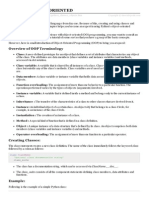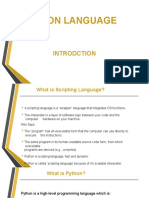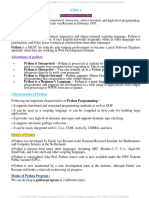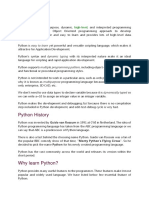Python
Uploaded by
rashed44Python
Uploaded by
rashed44+
Python
MD.Rasheduzzaman ID:0910647044 MD. Mahabub Akram ID:0910
Introduction
Python is created in 1990 by Guido van Rossum
Python is a well worked out coherent dynamic programming language Designed to be easy to learn and master
1. Clean, clear syntax
2. very few keywords
Highly portable
1. runs almost anywhere
2. Uses machine independent byte-codes
Features
Clean syntax plus high-level data type
1.leads to fast coding
Uses white-space to delimit blocks
Variables do not need declaration
1. although not a type-less language
Productivity
Reduce development time
1.code is 2-10x shorter that C, C++, Java
Improved program maintenance
1.code is extremely readable
Less training 1.language is very easy to learn
Usability
Rapid prototyping
Web scripting Throw-way, ad hoc programming Steering scientific programming Extension language XML processing Database application
GUI application
A Glue language
Python vs. Java
Code 5-10 times more concise
Dynamic typing Much quicker development
1.no compilation phase
2.less typing
Python is slower but development is so much faster Python can be used with Java: Jython
Python Basic
Variable need no declaration
>>>a=1 >>>a 1
Variable name alone is an expression, so the result is printed Variables must be created before they can be used
>>>b Traceback (most recent call last): File "<pyshell#2>", line 1, in <module> b NameError: name 'b' is not defined
Variables and Types
Objects always have a type
>>>a=1 >>>type(a) <type int> >>>a=hello >>>type(a) <type string>
Simple Data types
String
1.May hold any data, including embedded NULLs 2.Declared using either single, double, or triple quotes
>>> s=Hi there
>>>s Hi there >>>s=Embedded quote >>>s Embedded qoute
Simple Data Types
Integer object implemented using C longs
Float types implemented using C doubles Long Integers have unlimited size
1.limited only be available memory
>>>long = 1L << 64 >> long ** 5 2135987035920910082395021706169552114602704522 3566527699470416078222197257806405500229620869 36576L
High Level Data Types
Lists hold a sequence of items
1.May hold any object 2. Declared using square brackets
>>>l = [] #an empty list >>>l.append(1) >>>l.append(Hi there); >>>len(l) 2 >>>l [1, Hi there]
High Level Data Types
Dictionaries hold key-value pairs
1.Often called maps or hashes. Implemented using hash-table 2.Keys can any immutable objects, values
3.Declared using braces
>>> d={} >>d[0]=Hi there >>d[foo]=1 >>>len(d) 2 >>>d[foo] 1
Blocks
Blocks are delimited by indentation
1.Colon used to start a block 2.Tabs or spaces may be used
>>> if 1:
print true true
Looping
The for statement loops over sequences
>>> for ch in hello: print ch h e l l o >>> for i in range(3): print i 1 2 3
Functions
Functions are defined with the def statement:
>>>def foo(bar): return bar >>>
This defines a trivial function named foo that takes a single parameter bar The function object can be called:
>>>foo(3) 3
Class
Class are defined using the class statement
>>>class Foo: def __init__(self): self.member=1 def getMamber(self): return self.member >>>
The constructor has a special name __init__,while a destructor uses __del__ The self parameter is the instance Classes are instantiated using call syntax
>>>f=Foo() >>>f.getMember()
Modules
Most of pythons power comes from modules
Modules can be implemented either in Python, or in C/C++ Import statement makes a module available
>>>import string
>>> string.join( [Hi, there] ) Hi there >>>
Thank You
You might also like
- Python Programming Tutorial by Easylearning GuruNo ratings yetPython Programming Tutorial by Easylearning Guru26 pages
- Introduction To Programming Language PythonNo ratings yetIntroduction To Programming Language Python40 pages
- Python Notes Second Semester BVOC Computer ApplicationNo ratings yetPython Notes Second Semester BVOC Computer Application27 pages
- Python GTU Study Material E-Notes Unit-1 12012021081509AM100% (1)Python GTU Study Material E-Notes Unit-1 12012021081509AM29 pages
- JNTUA Python Programming & Data Science Notes - R20No ratings yetJNTUA Python Programming & Data Science Notes - R20183 pages
- Data Analysis Bootcamp Week 1 Study NoteNo ratings yetData Analysis Bootcamp Week 1 Study Note43 pages
- Object Oriented Programming Using Python: Name:Ankeet Giri Reg No.: 11904096No ratings yetObject Oriented Programming Using Python: Name:Ankeet Giri Reg No.: 1190409620 pages
- CMSC 420: Lecture 12 Balancing by Rebuilding - Scapegoat TreesNo ratings yetCMSC 420: Lecture 12 Balancing by Rebuilding - Scapegoat Trees5 pages
- N Efficient Framework For Learning Sentence RepresentationsNo ratings yetN Efficient Framework For Learning Sentence Representations16 pages
- Tutorial 1 Fundamentals: Review of Derivatives, Gradients and HessiansNo ratings yetTutorial 1 Fundamentals: Review of Derivatives, Gradients and Hessians25 pages
- 1999 MIT Press, Cambridge Mass., 2000. Chapter 3, Pages 25-39No ratings yet1999 MIT Press, Cambridge Mass., 2000. Chapter 3, Pages 25-394 pages
- Economic Order Quantity (EOQ) Model: Dr. Rakesh KumarNo ratings yetEconomic Order Quantity (EOQ) Model: Dr. Rakesh Kumar6 pages
- Shuffled Frog Leaping Algorithm A Memetic Meta Heuristic For Discrete OptimizationNo ratings yetShuffled Frog Leaping Algorithm A Memetic Meta Heuristic For Discrete Optimization27 pages
- Damy J Soil Stresses Under A Polygonal Area Uniformly Loaded PDFNo ratings yetDamy J Soil Stresses Under A Polygonal Area Uniformly Loaded PDF3 pages
- Automated Design of A Computer Vision System For Visual Food Quality EvaluationNo ratings yetAutomated Design of A Computer Vision System For Visual Food Quality Evaluation16 pages
- CE6102 - 6 - Geometric Nonlinearity - Large Strain and Large Deformation ProblemsNo ratings yetCE6102 - 6 - Geometric Nonlinearity - Large Strain and Large Deformation Problems16 pages
- State Estimation For Dynamic Weighing Using KalmanNo ratings yetState Estimation For Dynamic Weighing Using Kalman12 pages
- Elgamel Digital Signature Scheme (Rahat Ali ^J Roll No. -31No ratings yetElgamel Digital Signature Scheme (Rahat Ali ^J Roll No. -319 pages
- Math5_Q3_M19_Measuring the Circumference of a Circle Using Appropriate ToolsNo ratings yetMath5_Q3_M19_Measuring the Circumference of a Circle Using Appropriate Tools17 pages
- Stage-2 S-203 - Business Mathematics & StatisticsNo ratings yetStage-2 S-203 - Business Mathematics & Statistics3 pages
- Profits and Position Control: A Week of Dealing: ElsevierNo ratings yetProfits and Position Control: A Week of Dealing: Elsevier19 pages
- (Ebook) Fundamentals of spectrum analysis by Christoph Rauscher, Volker Janssen, Roland Minihold ISBN 9783939837015, 3939837016 2024 scribd download100% (1)(Ebook) Fundamentals of spectrum analysis by Christoph Rauscher, Volker Janssen, Roland Minihold ISBN 9783939837015, 3939837016 2024 scribd download67 pages
- Position Analysis of A 4 Bar PRRP Linkage Using Complex NumbersNo ratings yetPosition Analysis of A 4 Bar PRRP Linkage Using Complex Numbers6 pages
- Section 6 - Local Effects 6.2 Drifting at Projections and ObstructionsNo ratings yetSection 6 - Local Effects 6.2 Drifting at Projections and Obstructions2 pages
- (Problem Books in Mathematics) Vladimir V. Tkachuk (Auth.) - A Cp-Theory Problem Book - Special Features of Function Spaces-Springer International Publishing (2014) PDF100% (1)(Problem Books in Mathematics) Vladimir V. Tkachuk (Auth.) - A Cp-Theory Problem Book - Special Features of Function Spaces-Springer International Publishing (2014) PDF595 pages












































































































